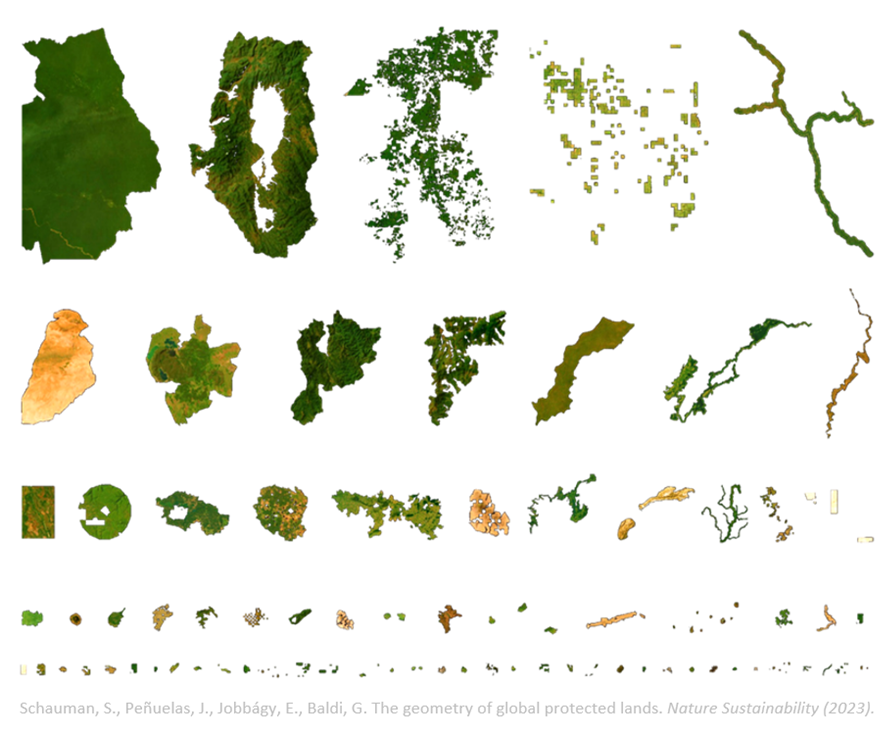A third of the world’s protected land is exposed to high human pressure
At the biodiversity conference in Montreal, in December 2022, governments from around the world agreed to protect 30% of Earth’s surface by 2030. That goal is halfway to being met, with approximately 266,983 protected areas covering 15.95% of global land. According to a new study, however, simply reaching 30% may not be enough unless other factors are taken into account, such as the geometry of protected areas and interaction between protected land and its unprotected surroundings. The research has been published in the journal Nature Sustainability and was carried out by CSIC and CREAF researcher Josep Peñuelas and a team from CONICET, Argentina’s National Scientific and Technical Research Council.
A mere 0.6% of protected land is further than 100 km from the unprotected matrix.
The study’s authors examined the geometry (shape) and distribution of all the world’s protected areas, except those in Antarctica and Greenland. One of their main findings was that a third of the planet’s protected land is in the “contact zone”, i.e. within 2 km of unprotected areas, and almost two thirds of protected land lies at a distance of under 10 km from unprotected areas. A mere 0.6% of protected land is further than 100 km from the unprotected matrix.
Disparity in geometry
Another striking finding was that the smallest and least compact protected areas are located in the world’s most critically endangered biomes and have strict biodiversity conservation objectives (corresponding to categories I and II, as defined by the International Union for the Conservation of Nature). According to Peñuelas, they are actually no less exposed to human influence than areas in which anthropogenic activity is permitted.

“We have seen that some protected areas are just as exposed to human influence as areas in which human activity is allowed are.”
JOSEP PEÑUELAS, CSIC and CREAF researcher.
The authors also point out that the most meaningful conservation work, in terms of establishing large, compact protected areas (where human pressure is kept further away from the protected inner core), has been carried out by peripheral or developing countries.In contrast, most developed (i.e. capital-rich and industrialized) countries have designated highly modified land for conservation, in relatively small units with particularly complex, perforated, fragmented shapes.
The study revealed that nine of the 14 terrestrial biomes (parts of the planet that have the same climate, flora and fauna) have 95% of their protected land (excluding rock and ice) within 30 km of unprotected areas. Higher proportions of protected land lying more than 30 km from unprotected areas are only found in ecosystems such as deserts and arid shrublands; tropical moist forests; tundra; tropical and subtropical grasslands and savannas; and flooded grasslands and savannas. The study found the most extreme case to be temperate broadleaf and mixed forests: 95% of protected land of this type is within 8 km of boundaries with unprotected areas.
The study found the most extreme case to be temperate broadleaf and mixed forests: 95% of protected land of this type is within 8 km of boundaries with unprotected areas.
The exposure level of protected land differs substantially among the world’s main cultural regions. For example, approximately 95% of the protected land in western Europe lies within 10 km of unprotected areas, in comparison to just 45% in the case of sub-Saharan Africa.

In the words of the study’s lead author, Santiago Schauman: “Little attention has been paid to the level of contact and interaction between protected areas and their unprotected surroundings, or to what it entails for critical issues such as the extent to which human influence can penetrate protected ecosystems.”
Rethinking protected areas
The study identified two traits of the geometry of protected land which are crucial to conservation strategies but have not been taken into consideration before now. The first is the “contact zone”, a term that refers to land under 2 km inside the boundaries of a protected area. Despite being protected, such land is in very close proximity to unprotected surroundings, making it highly vulnerable to anthropogenic pressure.
Additionally, “from the perspective of human health, contact zones can be conducive to the transmission of pathogens that might cause zoonotic diseases and even pandemics,” remarks Peñuelas. To reduce that risk, the researchers note, the level of contact between species from inside and outside protected areas should be factored into the design of networks of such areas.
Josep Peñuelas highlights that “from the perspective of human health,” says Josep Peñuelas, “contact zones can be conducive to the transmission of pathogens that might cause zoonotic diseases and even pandemics.”
The second trait identified in the study is “exposure level”, i.e. the distance between unprotected land and the interior of a protected area.
As human pressure on the biosphere intensifies, contact and interaction between protected land and its unprotected surroundings will have ever-greater implications for biodiversity conservation and human wellbeing. With that in mind, observes Schauman, “debate on the spatial geometry of protected areas is becoming urgent if the long-term conservation of nature is not to be placed in jeopardy.”
Referenced article
Schauman, S., Peñuelas, J., Jobbágy, E.G., Baldi, G. 2023. The geometry of global protected lands: implications for nature conservation and human well-being. Nature Sustainability.







